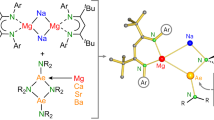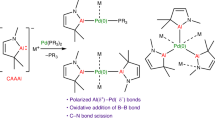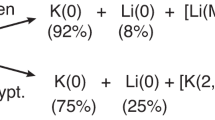Abstract
THE tris-oxalato-complexes of the general formula K3[M(C2O4)] xH2O (I), where M can be aluminium, vanadium, chromium, iron, cobalt, rhodium, iridium and several other metals [x varies, being 3 for aluminium, vanadium, chromium and iron; 3.5 for cobalt; and 4.5 for rhodium and iridium], have played a leading part in many aspects of co-ordination chemistry during the past 50 years. A great deal of work refers1 to their spectroscopic behaviour (where they are normally considered as tris-chelate compounds), their kinetic behaviour in solution, and, in some cases, their resolution into enantiomers.
This is a preview of subscription content, access via your institution
Access options
Subscribe to this journal
Receive 51 print issues and online access
$199.00 per year
only $3.90 per issue
Buy this article
- Purchase on Springer Link
- Instant access to full article PDF
Prices may be subject to local taxes which are calculated during checkout
Similar content being viewed by others
References
Harris, G. M., and Krishnamurty, K., Chem. Rev., 61, 214 (1961).
Gutowsky, H. S., Porte, A. L., and Harris, G. M., J. Chem. Phys., 34, 66 (1961).
van Niekerk, J., and Schoening, R., Acta Crystallog., 5, 196 (1952).
Herpin, P., Bull. Soc. Franc. Min., 81, 245 (1958).
Author information
Authors and Affiliations
Rights and permissions
About this article
Cite this article
FENN, R., GRAHAM, A. & GILLARD, R. Structures of Tris-oxalato-complexes of Trivalent Metals. Nature 213, 1012–1013 (1967). https://doi.org/10.1038/2131012a0
Received:
Issue Date:
DOI: https://doi.org/10.1038/2131012a0
This article is cited by
-
Electric field gradient on the iron nucleus caused by the formation of an oxalate bridge in chelate ferrooxalato complexes
Journal of Structural Chemistry (1975)
Comments
By submitting a comment you agree to abide by our Terms and Community Guidelines. If you find something abusive or that does not comply with our terms or guidelines please flag it as inappropriate.



